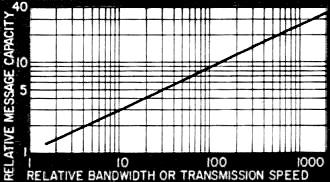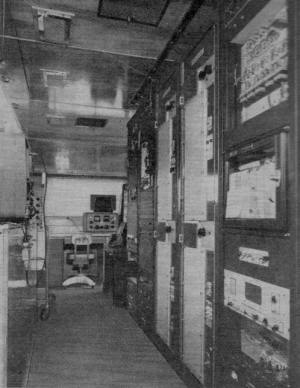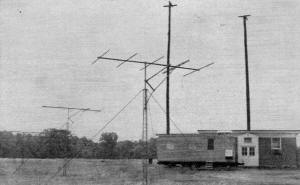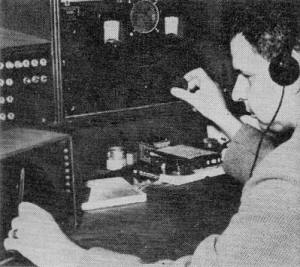|
July 1958 Radio-Electronics
 [Table of Contents] [Table of Contents]
Wax nostalgic about and learn from the history of early electronics.
See articles from Radio-Electronics,
published 1930-1988. All copyrights hereby acknowledged.
|
Long distance communications
(DX) thrives on ionized atmosphere. It causes boundary layers at various altitudes
that function as reflecting surfaces and thereby facilitate the "bouncing" of radio
waves off the sky so that they bend around the curvature of the Earth. Early sounding
rocket experiments verified that indeed ionized layers of atmosphere did exist as
suspected based on theories of aurora activity during periods that correlated with
observed solar flare activity. Intense solar flare periods are associated with large
numbers of sun spots, since coronal mass ejections (CMEs) are produced which supply
enormous amounts of electrons traveling at high speed earthward. CME matter of course
shoots in all directions, but only those moving in the direction of the Earth matter
to us. Amateur and professional, as well as military and academic communications
practitioners learned to exploit not only the fairly regular diurnal ionization
of the upper atmosphere for DX operation, but also learned to use the ionized trails
left by meteors passing through the sky for temporary long distance paths not possible
with predictable scenarios. In fact, many contests have been won based on a lucky
meteor "burst" that opened a communications channel just long enough to make official
contact with another operator somewhere in a distant land. It might not sound like
such a big deal today where you can talk to someone anywhere in the world on a standard
telephone or via the Internet using VoIP, but there was a time when it was magic.
To many Hams, it still is magic.
RF Cafe visitor Denny Condron (Tracking
Down a Mystery Signal) is an avid meteor detector and posted a link to
this article on the
RadioMeteors
Google group.
See also Meteor Detection by Amateur Radio, July 1947 QST
Communications via Meteor Bursts
Meteors and modern techniques combine to give longer-range two-way) communications
in the 30-100-mc band
By G. Franklin Montgomery

Fig. 1 - Sketch of typical meteor-burst signals shows amplitude
and duration of received information.
During the early Forties, when the FM broadcast service was operating in its
old band at 42 to 50 mc, Federal Communications Commission monitoring engineers
discovered a strange effect. Short bursts of signal were received occasionally from
FM stations as far as 1,370 miles away. This distance was much greater than the
100 miles or so considered maximum line-of-sight. The signal bursts were brief,
usually lasting for less than a second. They showed none of the characteristics
associated with known abnormal propagation such as ionospheric sporadic-E transmission
or atmospheric bending.
After a careful study, E. W. Allen, Jr.1 identified the bursts with
individual meteors, the small outer-space particles of matter that plunge into the
atmosphere by the billions each day. This intermittent vhf propagation over intermediate
distances has led to some unusual developments.
Meteor bursts are signal reflections from the atmospheric ionization that these
high-speed particles produce. Ranging in size from almost microscopic grains to
an occasional mass of rock or iron weighing several tons, meteors enter the atmosphere
at velocities as great as 40 miles per second. At an altitude of about 60 miles,
their friction with the thin atmosphere produces temperatures high enough to melt
vaporize the meteor anti to split molecules of the air into ions and free electrons.
In the meteor's wake, a miniature ionosphere is formed in the shape of a slender,
slowly expanding cylinder, perhaps several miles in length. The ions and electrons
produced by this process eventually recombine to form neutral gas molecules, but
it may take many seconds for them to do so.
Early Experiments

Fig. 2 - Message capacity plotted against bandwidth or transmission
speed.
After the war, to study meteor behavior, a number of experimenters began measuring
radio reflections from meteor trails with vhf radar equipment. About 1950, the idea
occurred almost simultaneously to several engineers that meteors might provide useful
radio communication from one point to another. Shortly thereafter, groups at the
Defence Research Telecommunications Establishment (Canada), the National Bureau
of Standards, the Stanford Research Institute and RCA Laboratories began work to
develop regular communication by this means.2 Amateurs in the US also
began work with similar techniques.3
Suppose we have two stations, A and B, about 1,000 miles apart. Each station
has a transmitter and receiver with antennas beamed toward a patch of sky (about
60 miles up) that can be seen from both stations. Each transmitter radiates a carrier
wave continuously. Receiver A is tuned to transmitter B, receiver B to transmitter
A. (Transmitter frequencies must differ slightly so transmitter A will not interfere
with receiver A, nor transmitter B with receiver B.) Ordinarily, each station receives
only a very weak signal or none at all. But from time to time, a meteor will pass
through the part of the atmosphere included in the antenna beams of both stations.
As it does so, it produces a trail of ionization. If this trail is oriented properly
with respect to the stations, both will receive a signal burst that may last from
less than 1/10 second to many seconds before it fades into the background noise.
Fig. 1 shows the kind of variation that is typical of separate meteor bursts.
In addition to the main outlines of an abrupt rise and slow decay in signal amplitude,
subsidiary fading is often observed on some bursts. The fading is attributed to
breakup of the trail by high-altitude atmospheric winds.
Speeded-up Transmission
Stations A and B can communicate with each other during these brief intervals.
With ordinary equipment, however, communication is difficult or impossible with
the signal lasting for so short a time. Modern information-handling techniques now
come into play. If A is to send a message to B, the message can be stored at A in
record form - on magnetic drums or tape, for example. When a signal burst occurs
at A, the recorded message is played back at high speed and modulates A's transmitter.
The same high-speed message at the output of B's receiver is recorded at B. Subsequently,
when the signal burst has passed, B's record is played back at normal speed so that
the message can be understood.

Interior of trailer. Two racks to the rear contain
receiving and control equipment. Two central racks are magnetic tape storage, record
and play. back units for transmitting and receiving. Tape is stored in vertical
perforated metal tanks. Foremost rack contains monitoring equipment.
This general procedure is the basis for burst communication. Storing in-formation
at normal speed, playback and transmission at high speed, reception and recording
at high speed, and playback at normal speed are common to all systems now in development.
Teletypewriter, voice and even facsimile modulation have been used successfully
in meteor-burst experiments. Usually the goal is two-way communication, with both
stations transmitting and receiving different messages simultaneously, using the
same signal burst. This end has already been achieved with teletypewriter messages
sent at up to 40 times the normal speed of 60 words per minute.
In addition to the recording equipment, control circuits are required at each
station to perform certain functions automatically. When a burst is received, there
must be a threshold device to judge whether the signal amplitude of the burst is
large enough to warrant starting transmission. If it is, the high-speed record and
playback units must be signaled to start. When the received burst amplitude falls
below a preset threshold, these units must be stopped, and so on. In a two-way system,
it is almost certain that the received signals at both stations will not behave
in exactly the same manner. A code of check signals is often sent around the loop
from one station to the other and back before starting transmission from either.
This procedure may sound like a waste of precious transmitting time, but it is done
within a few milliseconds and greatly reduces the possibility of transmission errors.
Fundamental to any communication system is the signal-to-noise ratio at the receiver
while the message is in progress. If the message is sent more rapidly than normal,
the receiver bandwidth must be increased to avoid message distortion. An increased
receiver bandwidth admits more noise, which in itself may distort the message. In
conventional systems where communication is continuous, a compromise must therefore
be made between speed of transmission and degradation of the received signal-to-noise
ratio.
Long or Short; Large or Small?
In a meteor-burst system, where communication is intermittent, this compromise
has unique consequences. The signal bursts in such a system vary widely in amplitude
and duration. A few bursts have very large peak amplitudes; many more have small
amplitudes. A particular burst of any amplitude may be short, or it may last for
a relatively long time. The bursts can be predicted only statistically. Whether
the next burst will be large or small and exactly when it will occur are both matters
of chance.

Experimental meteor-burst communication station. Four Yagi antennas
are arranged in double arrays for transmitting and receiving. Radio and terminal
equipment are housed in trailer to the rear.
Now, in setting up a system, we may choose to operate only with the few bursts
of large amplitude and transmit at high speed. Alternatively, we may use the many
bursts of smaller amplitude, as well as the large ones, and transmit slowly.
The striking feature of meteor-burst statistics is that it pays to use only the
large bursts. The price that must be paid for using them effectively is transmission
speed and bandwidth. In addition, a longer wait is required between transmissions,
although this waiting period may be unimportant in some applications.
The faster we are prepared to transmit and record during a burst, and the fewer
bursts we use, the greater the message capacity of the system. (A convenient measure
of message capacity is the total length of message that can be sent over the system
in a period of time long enough to include a large number of bursts.) Fig. 2
illustrates this dependence. Relative message capacity and relative bandwidth or
transmission speed are plotted using logarithmic scales. The capacity is not directly
proportional to the bandwidth but increases more slowly. In a typical case, it is
proportional to the bandwidth or speed raised to about the 0.4 power.
Courtesy National Bureau of Standards Courtesy National Bureau of Standards
The choice of operating parameters for a meteor-burst system is made more difficult
by the erratic nature of the bursts. Their random occurrence and amplitudes would
not be particularly troublesome if we could depend upon known average occurrence
rates and average amplitudes. But we cannot.
We do know that a typical system of moderate power may operate with four or five
1-second bursts per minute on the average. Throughout the day, however, the actual
number of bursts per minute change from a high rate in the pre-dawn hours to a low
rate at sunset. The total number of bursts varies from day to day.
At any given time, there is a best section of sky toward which the antenna beams
should be pointed to intercept the greatest number of useful trails. The position
of this best section also changes throughout the day and probably with the seasons.
All these meteor-burst characteristics have been measured extensively, but they
must be known even more exactly to achieve the best communication performance.
Forward-Scatter Competition
In one sense, meteor-burst systems4 are competitors with ionospheric
forward-scatter systems. Both provide communication over the same distances in the
same part of the vhf spectrum, roughly 30-100 mc. However, meteor-burst systems
may be able to use higher frequencies than are profitable for ionospheric scatter.

Believed to be the only commercially available recording of the
radio signals from Sputnik I and II and Explorer I, II and III, Voices of the Satellites
is the work of Professor Thomas A. Benham of Haverford College, Haverford, Pennsylvania.
The signals were recorded with a specially built convertor-amplifier. Professor
Benham, who is totally blind, also produces a nonprofit science magazine on tape,
Science for the Blind, which issues 400 recordings per month. His satellite recording,
available on a 5-inch tape reel or 10-inch LP record, is distributed by Taben Recordings,
Box G-224, Ardmore, Pa, ($3.95)
One distinct advantage of meteor bursts is the lower power require. Most experimental
work has been done with transmitter powers from 100 watts to a few kilowatts. Operational
scatter systems usually require tens of kilowatts and high-gain antennas. While
high-gain antennas are certainly useful for meteor-burst work, satisfactory results
have been obtained with simple Yagis of moderate gain. The principal disadvantage,
of course, is the complex message-handling equipment needed at the terminals. Perhaps
this disadvantage will seem less severe after more experience with these devices.
Voice of the Satellites
The high frequencies (3 to 30 mc), which we depend on for both intermediate-
and long-distance communication, have been badly crowded for many years. During
ionospheric storms, high-frequency communication is often unreliable. Even so, there
is little hope that future technical improvements will provide space for all of
the services that would like to use this part of the spectrum. The situation is
rather like an overcrowded bus with more riders than seats. Those standing must
either ride uncomfortably until someone abandons a seat, or give up the idea of
riding altogether. Meteor-burst communication, it is hoped, will provide a larger
bus. The hope is bright enough that much effort is being spent on its development.
References
1 E. W. Allen, Jr., "Reflections of Very-High-Frequency Radio Waves from
Meteoric Ionization," Proceedings of the IRE, Vol. 36, No.3, pages 346-352; March,
1948.
2 Meteor-burst Communication Papers, Proceedings of the pages IRE, Vol.
45, No. 12 pages 1642-1736; December, 1957.
3 "ARRL Merit Award for 1955 Goes to W4HHK and W2UK," QST, Vol. 40, No.
10, page 62; October, 1956.
4 Scatter Propagation Issue, Proceedings of the IRE, Vol. 43, No. 10, pages 1173-1526;
October, 1955.
Posted June 10, 2021
(updated from original post on 5/6/2014)
|













